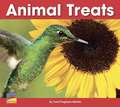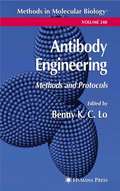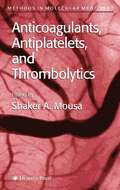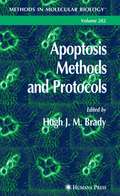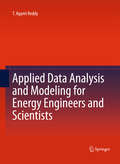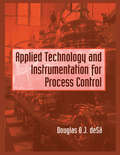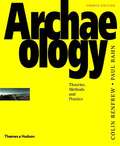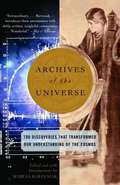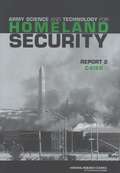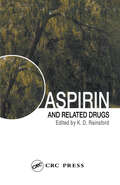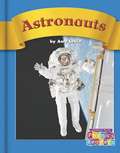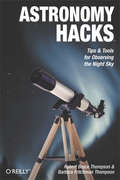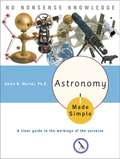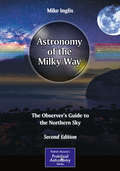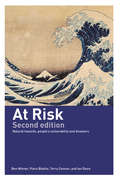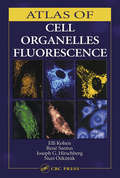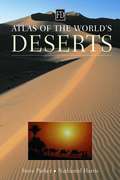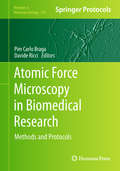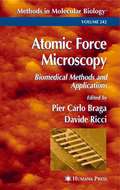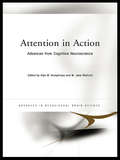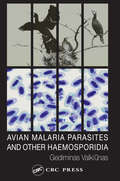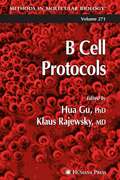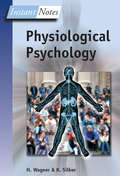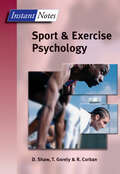- Table View
- List View
Animal Treats
by Carol Pugliano-Martin Barbara LevadiThis book is about making inferences about the types of food different animals eat.
Antibody Engineering: Methods and Protocols (Methods in Molecular Biology #248)
by Benny K. LoA core collection of diverse cutting-edge techniques for the generation, expression, optimization, and characterization of recombinant antibodies. Readily reproducible protocols for lead generation range from the cloning of human immunoglobulin genes to the selection and generation of human recombinant antibodies by humanization approaches, molecular display technologies and transgenic animals. Procedures are also described on restructuring antibody leads into monovalent, multivalent, and bispecific binding fragments for a wide variety of in vivo applications. State-of-the-art technologies are described for the characterization of antigen-binding affinity and specificity with novel applications in radioimmunotargeting, cancer immunotherapy, drug abuse, and proteomics.
Anticoagulants, Antiplatelets, and Thrombolytics: Methods And Protocols (Methods in Molecular Medicine #93)
by Shaker A. Mousa1This collection of review articles highlights the latest development of antithrombotics and provides proven experimental methods for the further development of new and improved anticoagulants. Among the cutting-edge developments reviewed are the novel usage of low molecular weight heparins, such antithrombin agents as the hirudin, and such antiplatelet drugs as the GPIIb/IIIa inhibitors and ADP receptor antagonists. Additional innovations discussed include aspirin and clopidogrel, the expanded use of polytherapeutic approaches, antiproteases (factors IIa, Xa, and VIIa), tissue factor targeting, platelet receptor targeting, and antithrombin III modulation.
Apoptosis Methods and Protocols (Methods in Molecular Biology #282)
by Hugh J. BradyA collection of cutting-edge techniques for detecting and quantifying apoptosis, understanding its biochemistry, and for identifying the genes and proteins that regulate and carry it out. Described in step-by-step detail, these readily reproducible methods range from flow cytometry and immunohistochemical procedures to kinase activity assays, yeast two-hybrid screening, and the cloning of novel genes by differential expression. The protocols follow the successful Methods in Molecular BiologyTM series format, each one offering step-by-step laboratory instructions, an introduction outlining the principle behind the technique, lists of equipment and reagents, and tips on troubleshooting and avoiding known pitfalls. Apoptosis Methods and Protocols constitutes a key technical reference to the significant methodologies used in the field, as well as offering novice and experienced researchers alike powerful tools to illuminate the phenomenon of programmed cell death.
Applied Data Analysis and Modeling for Energy Engineers and Scientists
by T. Agami ReddyApplied Data Analysis and Modeling for Energy Engineers and Scientists fills an identified gap in engineering and science education and practice for both students and practitioners. It demonstrates how to apply concepts and methods learned in disparate courses such as mathematical modeling, probability,statistics, experimental design, regression, model building, optimization, risk analysis and decision-making to actual engineering processes and systems. The text provides a formal structure that offers a basic, broad and unified perspective,while imparting the knowledge, skills and confidence to work in data analysis and modeling. This volume uses numerous solved examples, published case studies from the author's own research, and well-conceived problems in order to enhance comprehension levels among readers and their understanding of the "processes"along with the tools.
Applied Technology and Instrumentation for Process Control
by Douglas O. de SaApplied Technology and Instrumentation for Process Control presents the complex technologies of different manufacturing processes and the control instrumentation used. The large variety of processes prohibits covering more than a few. Carefully selected and diverse, but representative, examples show how fundamentally basic simpler elements or techn
Archaeology: Theories, Methods, and Practice (4th Edition)
by Colin Renfrew Paul BahnA textbook on archaeology: its history; the variety of evidence; survey and excavation of sites and features; dating methods; social, environmental and cognitive archaeology; 5 case studies, and the archaeology of people.
Archives of the Universe: 100 Discoveries that Transformed Our Understanding of the Cosmos
by Marcia BartusiakAn unparalleled history of astronomy presented in the words of the scientists who made the discoveries. Here are the writings of Copernicus, Galileo, Kepler, Newton, Halley, Hubble, and Einstein, as well as that of dozens of others who have significantly contributed to our picture of the universe. From Aristotle's proof that the Earth is round to the 1998 paper that posited an accelerating universe, this book contains 100 entries spanning the history of astronomy. Award-winning science writer Marcia Bartusiak provides enormously entertaining introductions, putting the material in context and explaining its place in the literature. Archives of the Universeis essential reading for professional astronomers, science history buffs, and backyard stargazers alike.
Army Science And Technology For Homeland Security: Report 2
by Committee on Army Science Technology for Homeland Defense--C4ISRShortly after the events of September 11, 2001, the U.S. Army asked the National Research Council (NRC) for a series of reports on how science and technology could assist the Army meet its Homeland defense obligations. The first report, Science and Technology for Army Homeland Security—Report 1, presented a survey of a road range of technologies and recommended applying Future Force technologies to homeland security wherever possible. In particular, the report noted that the Army should play a major role in providing emergency command, control, communications, computers, intelligence, surveillance, and reconnaissance (C4ISR) capabilities and that the technology and architecture needed for homeland security C4ISR was compatible with that of the Army’s Future Force. This second report focuses on C4ISR and how it can facilitate the Army’s efforts to assist the Department of Homeland Security (DHS) and emergency responders meet a catastrophic event.
Aspirin and Related Drugs
by K. D. RainsfordReviewing over a century of aspirin research and use, Aspirin and Related Drugs provides a comprehensive source of information on the history, chemistry, absorption in the body, therapeutic effects, toxicology, elimination, and future uses of aspirin.Highlighting the historical evolution of the salicylates and the commercial development of
Astronauts
by Amy LevinPhonics Readers is a recognized leader in helping you teach phonics and phonemic awareness, within the context of content-area reading. Content area focus: Space Explorers Phonics Skills: long o (o, oa, oe, ow), soft c
Astronomy Hacks: Tips and Tools for Observing the Night Sky
by Robert Bruce Thompson Barbara Fritchman ThompsonWhy use the traditional approach to study the stars when you can turn computers, handheld devices, and telescopes into out-of-this-world stargazing tools? Whether you're a first timer or an advanced hobbyist, you'll find Astronomy Hacks both useful and fun. From upgrading your optical finder to photographing stars, this book is the perfect cosmic companion.This handy field guide covers the basics of observing, and what you need to know about tweaking, tuning, adjusting, and tricking out a 'scope. Expect priceless tips and tools for using a Dobsonian Telescope, the large-aperture telescope you can inexpensively build in your garage. Get advice on protocols involved with using electronics including in dark places without ruining the party.Astronomy Hacks begins the space exploration by getting you set up with the right equipment for observing and admiring the stars in an urban setting. Along for the trip are first rate tips for making most of observations. The hacks show you how to:Dark-Adapt Your Notebook ComputerChoose the Best BinocularClean Your Eyepieces and Lenses SafelyUpgrade Your Optical FinderPhotograph the Stars with Basic EquipmentThe O'Reilly Hacks series has reclaimed the term "hacking" to mean innovating, unearthing, and creating shortcuts, gizmos, and gears. With these hacks, you don't dream it-you do it--and Astronomy Hacks brings space dreams to life. The book is essential for anyone who wants to get the most out of an evening under the stars and have memorable celestial adventures.
Astronomy Made Simple: A Clear Guide to the Workings of the Universe (Made Simple)
by Kevin B. Marvel Ph.D.See the skies in a whole new light. Take a tour of the universe, from our local solar system to the far reaches of deepest space. Astronomy Made Simple offers a complete introduction to this science, from its birth in ancient times to the different types of super-powerful telescopes scientists use today. It also includes detailed instructions on how to map the stars and understand the coordinate system, as well as fun sidebars, ideas for projects for further learning, and resources for the student or the amateur astronomer.
Astronomy Methods
by Hale BradtAstronomy Methods is an introduction to the basic practical tools, methods and phenomena that underlie quantitative astronomy. Taking a technical approach, the author covers a rich diversity of topics across all branches of astronomy, from radio to gamma-ray wavelengths. Topics include the quantitative aspects of the electromagnetic spectrum, atmospheric and interstellar absorption, telescopes in all wavebands, interferometry, adaptive optics, the transport of radiation through matter to form spectral lines, and neutrino and gravitational-wave astronomy. Clear, systematic presentations of the topics are accompanied by diagrams and problem sets. Written for undergraduates and graduate students, this book contains a wealth of information that is required for the practice and study of quantitative and analytical astronomy and astrophysics.
Astronomy of the Milky Way: The Observer’s Guide to the Northern Sky (The Patrick Moore Practical Astronomy Series)
by Mike InglisOne of the wonders of the universe we live in is the Milky Way. It spans the entire sky and can be seen every night of the year from anywhere on Earth. This is the first book that deals specifically with what can be seen within the Milky Way from a practical observer's point of view. Astronomy of the Milky Way covers every constellation that the Milky Way passes through, and describes in detail the many objects that can be found therein, including stars, double and multiple stars, emission nebulae, planetary nebulae, dark nebulae and supernovae remnants, open and galactic clusters, and galaxies. It also describes the one thing that is often left out of observing guides - the amazing star clouds of the Milky Way itself. It is one of a two-volume set that deal with the entire Milky Way - this second volume looks at what can be seen predominantly from the Southern skies In addition to the descriptive text there are many star charts and maps, as well as the latest up-to-date images made by observatories around the world and in space, as well as images taken by amateur astronomers. Equipped with this book, an amateur astronomer can go out on any clear night of the year and observe the galaxy we live in - The Milky Way.
At Risk: Natural Hazards, People's Vulnerability and Disasters
by Ian Davis Ben Wisner Piers Blaikie Terry CannonThe term 'natural disaster' is often used to refer to natural events such as earthquakes, hurricanes or floods. However, the phrase 'natural disaster' suggests an uncritical acceptance of a deeply engrained ideological and cultural myth. At Risk questions this myth and argues that extreme natural events are not disasters until a vulnerable group of people is exposed. The updated new edition confronts a further ten years of ever more expensive and deadly disasters and discusses disaster not as an aberration, but as a signal failure of mainstream 'development'. Two analytical models are provided as tools for understanding vulnerability. One links remote and distant 'root causes' to 'unsafe conditions' in a 'progression of vulnerability'. The other uses the concepts of 'access' and 'livelihood' to understand why some households are more vulnerable than others. Examining key natural events and incorporating strategies to create a safer world, this revised edition is an important resource for those involved in the fields of environment and development studies.
Atlas of Cell Organelles Fluorescence
by Elli Kohen Rene Santus Joseph G. Hirschberg Nuri OzkutukContaining over 150 original photomicrographs accompanied by protocol information, Atlas of Cell Organelles Fluorescence delineates organelles structures, interaction, and organization into complexes. It provides a collection that shows living cells under physiopathological conditions and in the context of treatment with carcinogens, xenobi
Atlas of the World's Deserts (Ecosystems Ser.)
by Nathaniel HarrisThe Atlas of the World's Deserts examines the hostile and extreme environments that characterize deserts, and is divided into chapters that concentrate on specific aspects of a desert's geology, life forms, history, and future.For more information including sample pages, visit the Atlas of the World's Deserts web site. Also includes 160 color maps and photos.
Atomic Force Microscopy in Biomedical Research: Methods and Protocols (Methods in Molecular Biology #736)
by Davide Ricci Pier Carlo BragaWith its ability to explore the surface of the sample by means of a local scanning probe and its use of dedicated software allows to be visualize results, atomic force microscopy (AFM) has revolutionized the study of the smallest aspects of life. Atomic Force Microscopy in Biomedical Research: Methods and Protocols proves that this technology is no longer simply just another form of microscopy but has given rise to a completely new way of using microscopy that fulfils the dreams of all microscopists: being able to touch, move, and interact with the sample while it is being examined, thus making it possible to discover not only morphological but also chemical and physical structural information. Covering such topics as molecule imaging, nanoscale surface analysis and cellular imaging, force-spectroscopy, investigating drug action, and AFM as a nanotool, this volume features the most up-to-date techniques currently in use. Written in the Methods in Molecular BiologyTM series format, chapters include introductions to their respective topics, lists of the necessary materials, step-by-step, readily reproducible protocols, and expert tips on troubleshooting and avoiding known pitfalls. Comprehensive and cutting-edge, Atomic Force Microscopy in Biomedical Research: Methods and Protocols brings together different types of applications in order to provide examples from diverse fields in the hope of inspiring researchers to apply their ingenuity in their own specialization and add significant originality to their varying studies.
Atomic Force Microscopy: Biomedical Methods and Applications (Methods in Molecular Biology #242)
by Davide Ricci Pier Carlo BragaHighly experienced physicians and biologists clearly explain the basic technical knowledge needed to use AFM and demonstrate its multifarious uses in biomedicine and the life sciences. The applications range widely from morphostructural analyses of cellular structures, to the investigation of subcellular structures, to functional investigations, and reveal a powerful new way of looking at biological samples. The methods clearly demonstrate the advantages of AFM over traditional life science microscopy, among them simultaneous very high magnification and resolution, minimal tissue and cell preparation, and the ability to obtain different views of the sample from a single data collection.
Attention in Action: Advances from Cognitive Neuroscience (Advances in Behavioural Brain Science)
by Glyn W. Humphreys M. Jane RiddochOver the past forty years much work has assessed how attention modulates perception, but relatively little work has evaluated the role of attention in action. This is despite the fact that recent research indicates that the relation between attention and action is a crucial factor in human performance. Attention in Action provides state-of-the-art discussion of the role of attention in action and of action in constraining attention. The research takes an interdisciplinary approach covering experimental studies of attention and action, neuropsychological studies of patients with impaired action and attention, single cell studies of cross-modal links in attention and action, and brain imaging studies on the underlying neural circuitry. Contributions from prominent international researchers both review the field and present new evidence, making this book an invaluable resource for researchers and therapists alike.
Avian Malaria Parasites and other Haemosporidia
by Gediminas ValkiunasWhen studying the effects of parasites on natural populations, the avian haematozoa fulfills many of the specifications of an ideal model. Featuring a multitude of tables and illustrations, Avian Malaria Parasites and Other Haemosporidia summarizes more than a century of research on bird haemosporidians. For a long time, bird blood parasites served as important models in studying human diseases. Although now largely replaced, the wealth of data and research remain. With chapters addressing life cycles and morphology, pathogenicity, ultrastructure, geographical distribution, and illustrated keys to all known species of the parasites, this book is a masterful assessment of the biology of bird haemosporidian parasites.
B Cell Protocols (Methods in Molecular Biology #271)
by Klaus Rajewsky Hua GuA diverse collection of protocols ranging from the latest inventions and applications to some classic, but still frequently used, methods for studying B-lymphocyte development and function in higher animals. These readily reproducible protocols follow the successful Methods in Molecular BiologyTM series format, each one offering step-by-step laboratory instructions, an introduction outlining the principle behind the technique, lists of equipment and reagents, and tips on troubleshooting and avoiding known pitfalls.
BIOS Instant Notes in Physiological Psychology (Instant Notes)
by Kevin Silber Hugh WagnerInstant Notes in Physiological Psychology provides a succinct overview of the key topics in physiological psychology, providing easy access to the core information in the field. Although physiological psychology is a required component of most degrees, the authors recognise that many students come from non-scientific backgrounds and may find the subject daunting. This book covers all of the essential topics in a format that is ideal for learning and rapid revision for students from all backgrounds. It can serve as a core text, supplemented by readings in the original literature, as a reference guide for students and lecturers alike, or as an ideal revision revision guide prior to exams.Instant Notes in Physiological Psychology is primarily intended for students taking a first course in the subject, but can also be used as an introduction to the field for undergraduates and graduates from other subject areas.
BIOS Instant Notes in Sport and Exercise Psychology (Instant Notes)
by Trish Gorely Dave Shaw Rod CorbanInstant Notes in Sport and Exercise Psychology provides concise coverage of sport and exercise psychology at the undergraduate level, and also covers the crucial basic psychology that underpins the subject. It has four main themes: theoretical approaches and research methods sport psychology at both the individual and group level of analysis exercise psychology practical applications including performance enhancement and ethics. Suitable for students in sport and exercise science, sport psychology, sport studies and sports management, it will be useful for coaches and athletes who wish to gain an up-to-date understanding of the key concepts, theories and research in this area.
